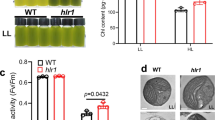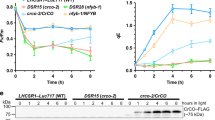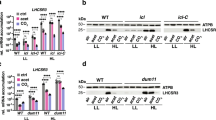Abstract
Light is necessary for photosynthesis, but its absorption by pigment molecules such as chlorophyll can cause severe oxidative damage and result in cell death. The excess absorption of light energy by photosynthetic pigments has led to the evolution of protective mechanisms that operate on the timescale of seconds to minutes and involve feedback-regulated de-excitation of chlorophyll molecules in photosystem II (qE). Despite the significant contribution of eukaryotic algae to global primary production1, little is known about their qE mechanism, in contrast to that in flowering plants2,3. Here we show that a qE-deficient mutant of the unicellular green alga Chlamydomonas reinhardtii, npq4, lacks two of the three genes encoding LHCSR (formerly called LI818). This protein is an ancient member of the light-harvesting complex superfamily, and orthologues are found throughout photosynthetic eukaryote taxa4, except in red algae and vascular plants. The qE capacity of Chlamydomonas is dependent on environmental conditions and is inducible by growth under high light conditions. We show that the fitness of the npq4 mutant in a shifting light environment is reduced compared to wild-type cells, demonstrating that LHCSR is required for survival in a dynamic light environment. Thus, these data indicate that plants and algae use different proteins to dissipate harmful excess light energy and protect the photosynthetic apparatus from damage.
This is a preview of subscription content, access via your institution
Access options
Subscribe to this journal
Receive 51 print issues and online access
$199.00 per year
only $3.90 per issue
Buy this article
- Purchase on Springer Link
- Instant access to full article PDF
Prices may be subject to local taxes which are calculated during checkout



Similar content being viewed by others
References
Field, C. B., Behrenfeld, M. J., Randerson, J. T. & Falkowski, P. Primary production of the biosphere: integrating terrestrial and oceanic components. Science 281, 237–240 (1998)
Ruban, A. V. et al. Identification of a mechanism of photoprotective energy dissipation in higher plants. Nature 450, 575–578 (2007)
Ahn, T. K. et al. Architecture of a charge-transfer state regulating light harvesting in a plant antenna protein. Science 320, 794–797 (2008)
Koziol, A. G. et al. Tracing the evolution of the light-harvesting antennae in chlorophyll a/b-containing organisms. Plant Physiol. 143, 1802–1816 (2007)
Schenck, H. On the focusing of sunlight by ocean waves. J. Opt. Soc. Am. 47, 653–657 (1957)
Niyogi, K. K. Photoprotection revisited: genetic and molecular approaches. Annu. Rev. Plant Physiol. Plant Mol. Biol. 50, 333–359 (1999)
Külheim, C., Ågren, J. & Jansson, S. Rapid regulation of light harvesting and plant fitness in the field. Science 297, 91–93 (2002)
Falkowski, P. G. et al. The evolution of modern eukaryotic phytoplankton. Science 305, 354–360 (2004)
Niyogi, K. K., Björkman, O. & Grossman, A. R. Chlamydomonas xanthophyll cycle mutants identified by video imaging of chlorophyll fluorescence quenching. Plant Cell 9, 1369–1380 (1997)
Elrad, D., Niyogi, K. K. & Grossman, A. R. A major light-harvesting polypeptide of photosystem II functions in thermal dissipation. Plant Cell 14, 1801–1816 (2002)
Merchant, S. S. et al. The Chlamydomonas genome reveals the evolution of key animal and plant functions. Science 318, 245–251 (2007)
Golan, T., Müller-Moulé, P. & Niyogi, K. K. Photoprotection mutants of Arabidopsis thaliana acclimate to high light by increasing photosynthesis and specific antioxidants. Plant Cell Environ. 29, 879–887 (2006)
Li, X.-P. et al. A pigment-binding protein essential for regulation of photosynthetic light harvesting. Nature 403, 391–395 (2000)
Gagné, G. & Guertin, M. The early genetic response to light in the green unicellular alga Chlamydomonas eugametos grown under light dark cycles involves genes that represent direct responses to light and photosynthesis. Plant Mol. Biol. 18, 429–445 (1992)
Savard, F., Richard, C. & Guertin, M. The Chlamydomonas reinhardtii LI818 gene represents a distant relative of the cabI/II genes that is regulated during the cell cycle and in response to illumination. Plant Mol. Biol. 32, 461–473 (1996)
Miura, K. et al. Expression profiling-based identification of CO2-responsive genes regulated by CCM1 controlling a carbon-concentrating mechanism in Chlamydomonas reinhardtii . Plant Physiol. 135, 1595–1607 (2004)
Zhang, Z. et al. Insights into the survival of Chlamydomonas reinhardtii during sulfur starvation based on microarray analysis of gene expression. Eukaryot. Cell 3, 1331–1348 (2004)
Naumann, B. et al. Comparative quantitative proteomics to investigate the remodeling of bioenergetic pathways under iron deficiency in Chlamydomonas reinhardtii . Proteomics 7, 3964–3979 (2007)
Ledford, H. K. et al. Comparative profiling of lipid-soluble antioxidants and transcripts reveals two phases of photo-oxidative stress in a xanthophyll-deficient mutant of Chlamydomonas reinhardtii . Mol. Genet. Genom. 272, 470–479 (2004)
Yamano, T., Miura, K. & Fukuzawa, H. Expression analysis of genes associated with the induction of the carbon-concentrating mechanism in Chlamydomonas reinhardtii . Plant Physiol. 147, 340–354 (2008)
Turkina, M. V. et al. Environmentally modulated phosphoproteome of photosynthetic membranes in the green alga Chlamydomonas reinhardtii . Mol. Cell. Proteom. 5, 1412–1425 (2006)
Allmer, J., Naumann, B., Markert, C., Zhang, M. & Hippler, M. Mass spectrometric genomic data mining: novel insights into bioenergetic pathways in Chlamydomonas reinhardtii . Proteomics 6, 6207–6220 (2006)
Bonente, G. et al. The occurrence of the psbS gene product in Chlamydomonas reinhardtii and in other photosynthetic organisms and its correlation with energy quenching. Photochem. Photobiol. 84, 1359–1370 (2008)
Alboresi, A., Caffarri, S., Nogue, F., Bassi, R. & Morosinotto, T. In silico and biochemical analysis of Physcomitrella patens photosynthetic antenna: identification of subunits which evolved upon land adaptation. PLoS One 3 10.1371/journal.pone.0002033 (2008)
Rensing, S. A. et al. The Physcomitrella genome reveals evolutionary insights into the conquest of land by plants. Science 319, 64–69 (2008)
Richard, C., Ouellet, H. & Guertin, M. Characterization of the LI818 polypeptide from the green unicellular alga Chlamydomonas reinhardtii . Plant Mol. Biol. 42, 303–316 (2000)
Wilson, A. et al. A soluble carotenoid protein involved in phycobilisome-related energy dissipation in cyanobacteria. Plant Cell 18, 992–1007 (2006)
Casper-Lindley, C. & Björkman, O. Fluorescence quenching in four unicellular algae with different light-harvesting and xanthophyll-cycle pigments. Photosynth. Res. 56, 277–289 (1998)
Moustafa, A. et al. Genomic footprints of a cryptic plastid endosymbiosis in diatoms. Science 324, 1724–1726 (2009)
Baroli, I., Do, A. D., Yamane, T. & Niyogi, K. K. Zeaxanthin accumulation in the absence of a functional xanthophyll cycle protects Chlamydomonas reinhardtii from photooxidative stress. Plant Cell 15, 992–1008 (2003)
Baroli, I., Do, A. D., Yamane, T. & Niyogi, K. K. Zeaxanthin accumulation in the absence of a functional xanthophyll cycle protects Chlamydomonas reinhardtii from photooxidative stress. Plant Cell 15, 992–1008 (2003)
Earley, K. et al. Gateway-compatible vectors for plant functional genomics and proteomics. Plant J. 45, 616–629 (2006)
Niyogi, K. K., Björkman, O. & Grossman, A. R. Chlamydomonas xanthophyll cycle mutants identified by video imaging of chlorophyll fluorescence quenching. Plant Cell 9, 1369–1380 (1997)
Porra, R. J., Thompson, W. A. & Kriedemann, P. E. Determination of accurate extinction coefficients and simultaneous equations for assaying chlorophylls a and b extracted with four different solvents: verification of the concentration of chlorophyll standards by atomic absorption spectroscopy. Biochim. Biophys. Acta 975, 384–394 (1989)
Richard, C., Ouellet, H. & Guertin, M. Characterization of the LI818 polypeptide from the green unicellular alga Chlamydomonas reinhardtii . Plant Mol. Biol. 42, 303–316 (2000)
Naumann, B. et al. Comparative quantitative proteomics to investigate the remodeling of bioenergetic pathways under iron deficiency in Chlamydomonas reinhardtii . Proteomics 7, 3964–3979 (2007)
Naumann, B., Stauber, E. J., Busch, A., Sommer, F. & Hippler, M. N-terminal processing of Lhca3 is a key step in remodeling of the photosystem-I light-harvesting complex under iron deficiency in Chlamydomonas reinhardtii . J. Biol. Chem. 280, 20431–20441 (2005)
Acknowledgements
We thank M. Guertin for providing the anti-LHCSR (LI818) antibody. This work was supported by grants from the Chemical Sciences, Geosciences and Biosciences Division, Office of Basic Energy Sciences, Office of Science, US Department of Energy (K.K.N.), the Deutsche Forschungsgemeinschaft (M.H.), and the National Science Foundation (A.R.G.).
Author Contributions G.P., T.B.T., E.O., A.B., D.E. and K.K.N. performed research; G.P., A.R.G., M.H., and K.K.N. designed research; G.P., M.H. and K.K.N. analysed data and wrote the paper; all authors discussed the results and commented on the manuscript.
Author information
Authors and Affiliations
Corresponding authors
Supplementary information
Supplementary Information
This file contains Supplementary Figures 1- 4 with Legends, Supplementary Methods, Supplementary Table 1 and Supplementary References. (PDF 1052 kb)
Rights and permissions
About this article
Cite this article
Peers, G., Truong, T., Ostendorf, E. et al. An ancient light-harvesting protein is critical for the regulation of algal photosynthesis. Nature 462, 518–521 (2009). https://doi.org/10.1038/nature08587
Received:
Accepted:
Issue Date:
DOI: https://doi.org/10.1038/nature08587
This article is cited by
-
Macroscale structural changes of thylakoid architecture during high light acclimation in Chlamydomonas reinhardtii
Photosynthesis Research (2024)
-
Proteomic characterization of a lutein-hyperaccumulating Chlamydomonas reinhardtii mutant reveals photoprotection-related factors as targets for increasing cellular carotenoid content
Biotechnology for Biofuels and Bioproducts (2023)
-
Widening the landscape of transcriptional regulation of green algal photoprotection
Nature Communications (2023)
-
Light-independent regulation of algal photoprotection by CO2 availability
Nature Communications (2023)
-
Weak acids produced during anaerobic respiration suppress both photosynthesis and aerobic respiration
Nature Communications (2023)
Comments
By submitting a comment you agree to abide by our Terms and Community Guidelines. If you find something abusive or that does not comply with our terms or guidelines please flag it as inappropriate.



